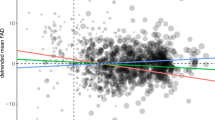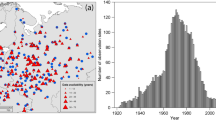Abstract
This paper analyses the dependence of the first spring arrival dates of short/medium- and long-distance migrant bird species on climate warming in eastern Europe. The timing of arrival of the selected species at the observation site correlates with the North Atlantic Oscillation (NAO) index, air temperature, atmospheric pressure, precipitation and wind characteristics. A positive correlation of fluctuations in winter and spring air temperatures with variations in the NAO index has been established in eastern Europe. Positive winter NAO index values are related to earlier spring arrival of birds in the eastern Baltic region and vice versa—arrival is late when the NAO index is negative. The impact of climate warming on the bird’s life cycle depends on local or regional climate characteristics. We tested the hypothesis that differences in climate indices between North Africa and Europe can influence the timing of spring arrival. Our results support the hypothesis that differences in first spring arrival dates between European populations occur after individuals cross the Sahara. We assume that the endogenous programme of migration control in short/medium-distance migrants synchronises with the changing environment on their wintering grounds and along their migration routes, whereas in long-distance migrants it is rather with environmental changes in the second part of their migratory route in Europe. Our results strongly indicate that the mechanism of dynamic balance in the interaction between the endogenous regulatory programme and environmental factors determines the pattern of spring arrival, as well as migration timing.






Similar content being viewed by others
References
Ahola M, Sippola K (2003) Timing of breeding and spring arrival of the Pied Flycatcher in relation to climatic fluctuation: a case study in SW—Finland. In: ESF workshop “Bird Migration and Climate Change”, Konstanz, March 13–15
Ahola M, Laaksonen T, Sippola K, Eeva T, Rainio K, Lehikoinen E (2004) Variation in climate warming along the migration route uncouples arrival and breeding dates. Global Change Biol 10:1–8; DOI 10.1111/j.1365-2486.2004.00823.x
Alerstam T (1990) Bird migration. Cambridge University Press, Cambridge, MA
Bairlein F, Winkel W (2001) Birds and climate change. In: Lozan JL, Hupfer P, Grabl H (eds) Climate of the 21st century: changes and risks. Wissenschaftliche Auswertungen, pp 278–282
Bartkeviciene G (2003) The impact of North Atlantic Oscillation on the Lithuanian climate. Dr. Thesis, Vilnius University, Vilnius
Bartkeviciene G (2005) Spatial peculiarities of the NAO impact on air temperature and precipitation field in 1950–2000. Acta Zool Lit 15:39–46
Berthold P (1990) Patterns of avian migration in light of current global “greenhouse” effects: a central European perspective. In: Acta XX congressus internationalis ornithologici, pp780–786
Berthold P (1996) Control of bird migration. Chapman & Hall, London
Berthold P (1998) Vogelwelt und Klima. Naturwissenschafliche Rundschau 9:337–346
Berthold P (1999) A comprehensive theory for the evolution, control and adaptability of avian migration. Ostrich 70:1–11
Berthold P (2001) Bird migration: a general survey, 2nd edn. Oxford University Press, Oxford
Berthold P (2002) Bird migration: the present view of evolution, control, and further development as global warming progresses. Acta Zool Sinica 48:291–301
Bolshakov CV, Payevsky VA (eds) (2001a–d) Ringing report. Results of bird ringing by the Biological Station “Rybachy” on the Courish Spit: long-distance recoveries of birds ringed in 1956–1997. Parts 1–4. In: Avian ecology and behaviour: proceedings of the biological station “Rybachy”, Supplement 1–4. St. Petersburg
Bolshakov CV, Payevsky VA (eds) (2002a–c) Ringing report. Results of bird ringing by the Biological Station “Rybachy”: controls of birds ringed outside the Courish Spit in 1956–1997. Parts 1–3. In: Avian ecology and behaviour: proceedings of the biological station “Rybachy”, Supplement 5–7. St. Petersburg
Both CH, Visser ME (2001) Adjustment to climate change is constrained by arrival date in a long-distance migrant bird. Nature 411:296–298
Bukantis A (1994) Extreme winters in the Baltic Sea area. In: Pauliukevicius G (ed) The geographical yearbook, vol 28. Institute of Geography, Lithuanian Geographical Society, Vilnius, pp 179–193
Bukantis A (1998) The variability of climatic elements on the Lithuanian territory (a monograph). Institute of Geography Publishers, Vilnius
Bukantis A (2001) Climatic fluctuations in Lithuania against a background of global warming. Acta Zool Lit 11:113–120
Bukantis A (2002) Application of factor analysis for quantification of climate-forming processes in the eastern part of Baltic Sea region. Climate Res 20:135–140
Bukantis A et al (2002) Daily dataset of 20th-century surface air temperature and precipitation series for the European Climate Assessment. Int J Climatol 22(12):1441–1453
Forchhammer MC, Post E, Stenseth NC (2002) North Atlantic Oscillation timing of long- and short-distance migration. J Anim Ecol 71:1002–1014
Gordo O, Brotons L, Ferrer X, Comas P (2005) Do changes in climate patterns in wintering areas affect the timing of the spring arrival of trans-Saharan migrant birds? Global Change Biol 11:12–21
Gwinner E (1986) Circannual rhythms. Springer, New York
Gwinner E (1996) Circadian and circannual programmes in avian migration. J Exp Biol 199:39–48
Hubalek Z (2003) Spring migration of birds in relation to North Atlantic Oscillation. Folia Zool 52:287–298
Hubalek Z (2004) Global weather variability affects avian phenology: a long-term analysis, 1881–2001. Folia Zool 53:227–236
Huin N, Sparks TH (1998) Arrival and progression of the Swallow Hirundo rustica through Britain. Bird Stud 45:361–370
Huin N, Sparks TH (2000) Spring arrival patterns of the Cuckoo Cuculus canorus, Nightingale Luscinia megarhynchos and Spotted Flycatcher Muscicapa striata in Britain. Bird Stud 47:22–31
Hüppop O, Hüppop K (2003) North Atlantic Oscillation and timing of spring migration in birds. Proc R Soc Lond B 270:233–240
Hurrell JW (2000) The North Atlantic Oscillation. In: Prepared for the national academy of sciences, 12th annual symposium on frontiers of science, Irvine, CA
Hurrell JW, Kushnir Y, Ottersen G, Visbeck M (2003) The North Atlantic Oscillation: climate significance and environmental impact . Geophy Monogr Ser 134:1–35
Jones PD, Jónsson T, Wheeler D (1997) Extension to the North Atlantic Oscillation using early instrumental pressure observations from Gibraltar and South—West Iceland. Int J Climatol 17:1433–1450
Lehikoinen E, Sparks T, Zalakevicius M (2004) Arrival and departure dates. In: Møller AP, Fiedler W, Berthold P (eds) Birds and Climate Change. Advances in Ecological Research, vol 35. Academic Press, NY, pp1–31
Lozan JL, Graßl H, Hupfer P (2001) Climate of the 21st century: changes and risks, scientific facts. Wissenschaftliche Auswertungen, Hamburg
Manabe S (1998) Study of global warming by GFDL climate models. R Swed Acad Sci Ambio 27:182–186
Mason CF (1995) Long term trends in the arrival dates of spring migrants. Bird Stud 42:182–189
Patapavicius R (1981–1989) Bird ringing in Lithuania. Annual reports: 1979–1988. Vilnius, Institute of Zoology and Parasitology (in Lithuanian)
Ramanathan V (1998) Trace-gas greenhouse effect and global warming. Royal Swedish Academy of Sciences. Ambio 27:187–197
Richardson WJ (1978) Timing and amount of bird migration in relation to weather: a review. Oikos 30:224–272
Richardson WJ (1990) Timing of bird migration in relation to weather: updated review. In: Gwinner E (ed) Bird migration. Springer, NY, pp 78–101
Saino N, Szep T, Romano M et al (2004) Ecological conditions during winter predict arrival date at breeding quarters in a trans-Saharan migratory bird. Ecol Lett 7:21–25
Sanz JJ (2002) Climate change and breeding parameters of great and blue tits throughout the western Palaearctic. Global Change Biol 8:409–422
Seather BE (2003) Climate effects on avian population dynamics. In: ESF workshop “Bird Migration and Climate Change”, Konstanz, March 13–15
Skuodis V, Kupryte A (1989) Bird ringing in Lithuania. Institute of Zoology and Parasitology, Vilnius
Sokolov LV, Kosarev VV (2003) Relationship between timing of arrival of passerines to the Courish Spit and North Atlantic Oscillation index (NAOI) and precipitation in Africa. Proc Zool Inst Russ Acad Sci 299:141–154
Sokolov LV, Markovets MY, Shapoval A.P. and Morozov YG (1998) Long-term trends in the timing of spring migration of passerines on the Courish Spit of the Baltic Sea. Avian Ecol Behav 1:1–21
Sokolov LV, Kosarev VV, Fedoseeva NV, Markovets MY, Shapoval AP, Yefremov VD (2003) Relationship between autumn numbers of the Coal Tit Parus ater, air temperatures and North Atlantic Oscillation index. Avian Ecol Behav 11:71–88
Sparks TH, Menzel A (2002) Observed changes in seasons: an overview. Int J Climatol 22:1715–1725 (DOI: 10.1002/joc.821)
Sparks T, Heyen H, Braslavska O, Lehikoinen E (1999) Are European birds migrating earlier? BTO News 223:8–9
Sparks T, Crick H, Woiwod I, Beebee T (2001) Climate change and phenology in the United Kingdom. In: Green R, Harley M, Spalding M, Zockler CH (eds) Impacts of climate change on wildlife (RSPB registered charity no. 207076), pp 53–55
Sparks TH, Crick HQP, Dunn PO, Sokolov LV (2003) Phenology of selected lifeforms: birds. In: Schwartz MD (ed) Phenology: an integrative environmental science. Kluwer Academic Publishers, Dordrecht, pp 421–436
Sparks TH, Bairlein F, Bojarinova JG, Hüppop O, Lehikoinen E, Rainio K, Sokolov LV, and Walker D (2005) Examining the total arrival distribution of migratory birds. Global Change Biol 11:22–30
Tryjanowski P, Sparks TH (2001) Is the detection of the first arrival date of migrating birds influenced by population size? A case study of the red-backed shrike Lanius collurio. Int J Biometeorol 45:217–219
Tryjanowski P, Kuzniak S, Sparks T (2002) Earlier arrival of some farmland migrants in western Poland. Ibis 144:62–68
Vähätalo AV, Rainio K, Lehikoinen A, Lehikoinen E (2004) Spring arrival of birds depends on the North Atlantic Oscillation. J Avian Biol 35:210–216
Vaitkevicius A, Skuodis V (1965) Bird migration. Mintis, Vilnius (in Russian)
Visbeck MH, Hurrell JW, Polvani L, Cullen HM (2001) The North Atlantic Oscillation: past, present, and future. Proc Nat Acad Sci USA 98:12,876–12,877
WMO (World Meteorological Organization) (1998) CLIVAR Initial Implementation Plan, WMO/TD No. 869
Zalakevicius M (1990) The study of mechanisms controlling migratory take-off in spring and autumn. Acta Ornithol Lit 3:3–52
Zalakevicius M (1997) Bird migration and climate change. Acta Zool Lit: Ornithol 6:20–30
Zalakevicius M (2001a) Bird migration and climate: a review of the studies conducted in Lithuania in the context of climate change. In: Zalakevicius M (ed) Fauna and climate change: part I. Acta Zool Lit 11:200–218
Zalakevicius M (2001b) Bird numbers, population state, and distribution areas in the Eastern Baltic region in the context of the impact of global climate change. In: Zalakevicius M (ed) Fauna and climate change: part I. Acta Zool Lit 11:141–162
Zalakevicius M (2002) Biophysical impacts of climate change on bird populations and migration in Lithuania. GeoJournal 57:191–201
Zalakevicius M, Svazas S (1997) The impact of global climate change on wildlife in Lithuania: theoretical and practical aspects. Acta Zool Lit: Ornithol 6:14–19
Zalakevicius M, Zalakeviciute R (2001) Global climate change impact on birds: a review of research in Lithuania. Folia Zool 50:1–17
Zalakevicius M, Svazas S, Stanevicius V, Vaitkus G (1995) Bird migration and wintering in Lithuania: a monograph. Acta Zool Lit 2:252
Acknowledgements
We thank Dr. Raimondas Idzelis and Liutauras Grigaliunas, who assisted with collection of material on the first spring arrival of birds. My thanks are also due to the postgraduate student Rasa Zalakeviciute-Grivicke from Vilnius University and DaivaVaitkuviene from the Institute of Ecology of Vilnius University, who collected material from the archives of the Lithuanian Hydro-Meteorological Service and to those from the same service, who offered assistance contributing to the publication of this article. We also thank anonymous referees for useful and precise proposals and improvements to the manuscript. Many thanks to Dr. Franz Bairlein and Dr. Anders P. Møller for invitation to join several special conferences and workshops enabling us to prepare this paper. Research was carried out by the Institute of Ecology of Vilnius University and it complies with current laws of The Republic of Lithuania.
Author information
Authors and Affiliations
Corresponding author
Additional information
Communicated by F. Bairlein
Appendix
Appendix
Rights and permissions
About this article
Cite this article
Zalakevicius, M., Bartkeviciene, G., Raudonikis, L. et al. Spring arrival response to climate change in birds: a case study from eastern Europe. J Ornithol 147, 326–343 (2006). https://doi.org/10.1007/s10336-005-0016-6
Received:
Revised:
Accepted:
Published:
Issue Date:
DOI: https://doi.org/10.1007/s10336-005-0016-6




